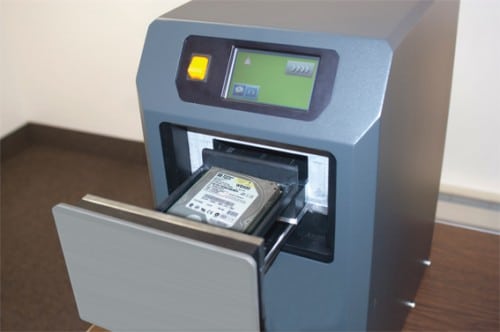Degausser Technology – Types of Degaussers
There are two basic technologies used in magnetic media degaussers to sanitize storage media. One is based on permanent magnet technology and the other on electromagnetic technology. Both types are capable of generating powerful magnetic fields.
Electromagnetic Degaussers
Electromagnetic degaussers remove data from magnetic media (hard drives, data tapes, etc.) by applying a very large, short duration magnetic field “pulse” to the media. An electrical charge is stored in large capacitors. When these capacitors are full, all of their energy is dumped into a coil of wire that surrounds the media which is positioned in a “Degausser Chamber”. The flow of current through the coil creates a large magnetic field that degausses the media inside the chamber.
Advantages of electromagnetic technology: Electromagnetic degaussers tend to be lighter, more portable and less expensive than similarly rated permanent magnetic degaussers.
Permanent Magnet Degaussers
Permanent magnet degaussers come in a variety of types. The most commonly used is a drawer style device that deploys DC erasure. This technology uses an array of Permanent Rare Earth Magnets to degauss the media. For the degaussing and erasure of both Unclassified and classified data, neodymium iron boron (symbol NdFeB) magnets are used. With the NdFeB permanent magnets arranged in a tested and validated structure, the degausser creates an intense magnetic field without requiring an electrical charge. The stored data on the magnetic media (hard drives or tapes) is erased prohibiting the media from continued use. A major disadvantage of permanent magnet technology is the expense. Creating rare earth magnetics involves a multi-step process that is both time consuming and expensive. Because of this, permanent magnet degaussers often cost two to three times more than electromagnetic degaussers with similar erasure capabilities.

Explore More
- Degausser Technology – Types of Degaussers
- Degaussers – How Can You Be Sure the Data is Gone?
- Mixed Media Destruction – Choose Versatility
- Optical Media Destruction
- Options for Physical Destruction of Storage Media
- Understanding Levels of Degaussing Power
- Use and Care of Electromagnetic Degaussers
- Use and Care of Hard Drive Crushers
- Use and Care of Hard Drive Shredders
- Use and Care of Mixed Media Destroyers
- Use and Care of Optical Media Shredders


